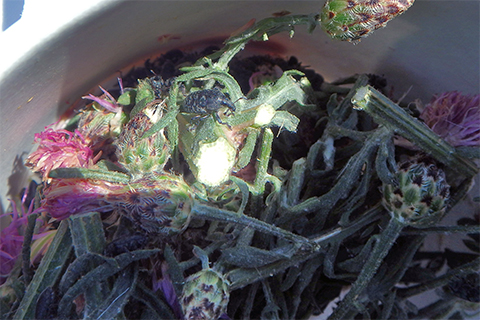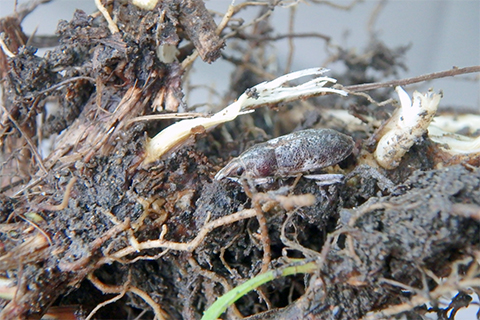Spotted knapweed is an aggressive invader that will colonize disturbed sites such as roadsides, farm fields, railroad beds, recently installed utility lines, and overgrazed land.
In Pennsylvania, spotted knapweed also can be found in dry woods, fields, and barrens.
Infestation of this plant generally leads to a decline in biodiversity because the invasive plant chokes out native vegetation.
It also can degrade soil and water quality by increasing erosion and surface runoff.
Because spotted knapweed is tough to eradicate with both mechanical and chemical methods, DCNR is enlisting some help from a friend -- the weevil.
About Spotted Knapweed

Spotted knapweed, Rob Routledge, Sault College, Bugwood.org
Spotted knapweed (Centaurea stoebe ssp. micranthos) is an invasive perennial plant with purple flowers and lobed leaves.
The plant was accidentally introduced into North America from Asia in the late 1800s. Since then, it has spread rapidly throughout the northeastern and mid-Atlantic states, and further west.
Here in Pennsylvania, we get significantly more rainfall than it would prefer, so spotted knapweed is generally less of an invasive problem.
However, in some of our state’s harsher environments -- roadsides, reclaimed minelands, and natural barrens -- it can still be a significant invader and push out native species that have evolved to cope with those sorts of dry, rocky, hot conditions -- like our native prickly pear species.

Native prickly pear
Spotted knapweed is often found in open, disturbed areas where it grows in tufted clumps.
Just one plant can grow up to 20 slender, upright stems 2- to 4-feet in height with thistle-like, pinkish-purple flower heads.
It is suspected of being able to produce chemicals to poison competing plants; however, scientists are still researching this.
Spotted knapweed reproduces solely by dispersing its seeds which are carried by the wind, birds, and other wildlife. Its seeds may remain viable in the soil for up to seven years.
Fighting Against Spotted Knapweed

Field infested with spotted knapweed, Leslie J. Mehrhoff, University of Connecticut, Bugwood.org
Spotted knapweed is a tough plant and can be difficult to remove mechanically or chemically.
If there are only a few plants in an area, they can be removed psychically, which is easiest when the soil is moist.
Be sure to remove the entire plant and bag and dispose of the plants in a landfill, to avoid dispersing seed or root fragments.
For larger populations, chemical control may be needed. A 3 percent solution of triclopyr herbicide should be applied to the leaves in early spring or fall.
This should be repeated several times a year for two or more years.
Biocontrol

Root-mining weevil
Combining the difficulty of mechanical and chemical control with its prevalence along roadsides, spotted knapweed makes a good target for biological control.
Biological control is when a natural predator or disease is introduced to control a pest or plant.
Thirteen insects have been released in the United States for knapweeds. Two species of weevil -- the seedhead weevil (Larinus obtusus) and the root-mining weevil (Cyphocleonus achates) -- were the most successful.
Both species were reviewed and approved by the U.S. Department of Agriculture to ensure they would only impact the spotted knapweed plants and not become an issue themselves.
Until recently, they were only released in the western United States, where they have had success at diminishing spotted knapweed infestations.

Seedhead weevil
Adult weevils appear from mid-July to September and lay eggs on the roots of larger spotted knapweed plants.
The eggs hatch quickly, and then the larvae devour the roots. They feed and grow throughout autumn, winter, spring, and early summer.
Soon after, they pupate inside the root and emerge as adults the following summer to repeat the process. The damage to the root caused by the larva is what can kill the spotted knapweed.

Spotted knapweed root showing damage from weevils
In 2015, DCNR released these species in Gallitzin State Forest at a reclaimed strip-mine -- an area with shallow, rocky soils that had been heavily invaded by spotted knapweed. Monitoring of these species continues annually.
While infestations of spotted knapweed at the site are decreasing in density, it is unknown whether this is because of the weevils’ life cycle success or the site building organic matter in the soil and favoring other plant species that compete with the spotted knapweed.

2015 release of weevils into a heavy spotted knapweed infestation
One of the two weevil species -- the root-mining weevil – has since been recaptured at the site, demonstrating success of its life cycle.
The seedhead weevil has not yet been recaptured, although this may be due to sampling methods.
Future releases of weevils and monitoring of their success are planned for spotted knapweed infestations in other state forest districts.
If homeowners are interested in purchasing weevils as spotted knapweed biocontrols, they can be found online at several distributors based in Montana.
Learn more about spotted knapweed and how to treat it from DCNR’s Spotted Knapweed Invasive Plant Fact Sheet (PDF) Learn more about invasive plants at the DCNR website.